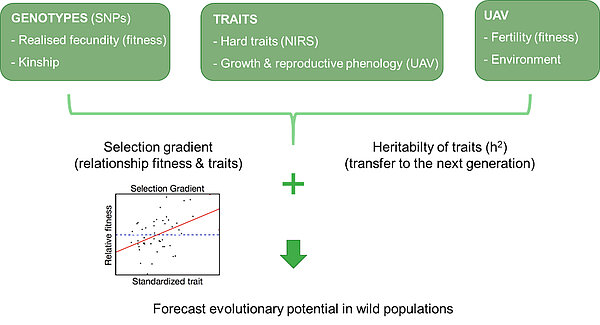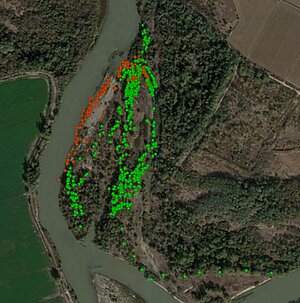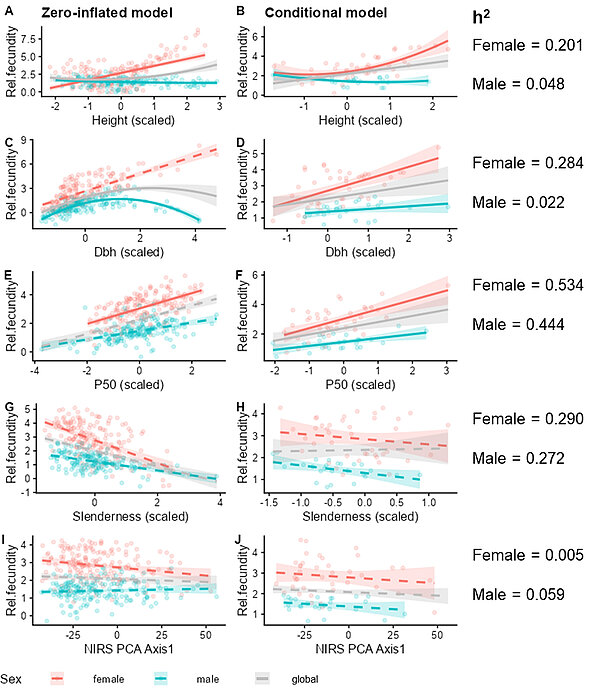Toward predicting the adaptability of genetic resources
Predicting the impacts of climate change on species distribution is essential for conserving resilient ecosystems. Populations can persist under new environments via plastic responses that allow a range of phenotypes to be expressed and by evolving in situ through local adaptation. To better predict the adaptive capacity of populations, assessing their evolutionary potential is key, as there is accumulating evidence of fast evolution of species in response to drastic changes in selection pressures. For evolution to happen there must exist levels of additive genetic variance within populations, as higher genetic diversity increases the chances of populations to harbour adaptive alleles to new environmental conditions. Additionally, adaptive traits should be transmitted from one generation to another, and therefore be heritable (measured as h2).
Within the European project FORGENIUS, activities in Work Package 3 (Assessing seed production and genetic resources adaptability) have been focusing on investigating the levels of additive genetic variance within Genetic Conservation Units (GCUs), together with the strength and direction of natural selection on different morphological and physiological traits. This research deals with large sample size (500 adults and 250 juveniles for eight populations spanning four tree species), integrates a wide array of datasets (genetic, phenotypic and environmental data), gathered through different methodologies (field measurements, molecular analyses, chemical laboratory analyses, images from unmanned aerial vehicle) carried on by experts from different research groups across European countries. Integrating these datasets into quantitative genetic models allowed us to estimate components of fitness (i.e. seed production), heritability of adaptive traits (e.g. height, diameter, hard-to-measure adaptive traits), and the relationship between traits and fitness in field conditions, with the ultimate goal of forecasting the GCU adaptability (see workflow below).


As an illustration, we present the case of the black poplar (Populus nigra), for which two GCUs with contrasted ecological conditions were selected in Austria and in Spain (Figure 1). Genotypic (thousands of SNPs), phenotypic (diameter at breast height (DBH), height, slenderness, near infrared spectra (NIRS), survival during drought measured as P50, seed count used as a proxy of fitness) and environmental (soil humidity, temperature, and NDVI) data were compiled for 500 adults in each GCU. While 250 juveniles per GCU were characterized only for genotypic data, to get another estimates of fitness via realised fecundity. Although the completion and curation of the datasets are still ongoing, preliminary analyses in the Spanish GCU are already providing interesting outcomes.
Results show that the studied traits present different levels of additive genetic variance within population, implying that most of them harbour potential to evolve (Figure 2). Three traits showed significant selection gradients (height, DBH and P50), most of them under directional selection (except DBH for male trees that shows stabilizing selection). More specifically, results suggest that taller trees and bigger trees have higher relative fecundity, as well as trees with higher P50. Interestingly, different levels of additive genetic variance and different selection pressures were found among sexes in this population. Overall, females seem to harbour higher levels of genetic variance and are subjected to higher directional selection pressures, which in turn imply higher evolutionary potential for females than for males in this population. As phenotypic traits do not evolve in isolation, work is still ongoing on the multivariate adaptive capacity (i.e., considering all measured traits and their relations) to provide more precise information on the evolutionary potential of this population.

The methodology presented here will, in the following months, be applied to the other GCUs as soon as the curated datasets become available. Inferring the evolutionary potential of the populations and comparing it under contrasted environmental conditions will provide valuable insights on their adaptive capacity under future environmental conditions.